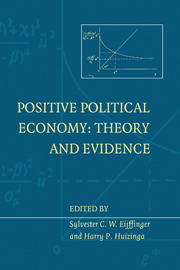Book contents
- Frontmatter
- Contents
- List of figures
- List of tables
- List of contributors
- Foreword
- Introduction
- I Monetary institutions and policy
- 1 Reputational versus institutional solutions to the time-consistency problem in monetary policy
- 2 Reciprocity and political business cycles in federal monetary unions
- 3 The ultimate determinants of central bank independence
- 4 Central bank autonomy and exchange rate regimes – their effects on monetary accommodation and activism
- 5 Uncertainty, instrument choice, and the uniqueness of Nash equilibrium: microeconomic and macroeconomic examples
- 6 New empirical evidence on the costs of European Monetary Union
- II Exchange rate policy and redistribution
- Index
6 - New empirical evidence on the costs of European Monetary Union
from I - Monetary institutions and policy
Published online by Cambridge University Press: 05 September 2013
- Frontmatter
- Contents
- List of figures
- List of tables
- List of contributors
- Foreword
- Introduction
- I Monetary institutions and policy
- 1 Reputational versus institutional solutions to the time-consistency problem in monetary policy
- 2 Reciprocity and political business cycles in federal monetary unions
- 3 The ultimate determinants of central bank independence
- 4 Central bank autonomy and exchange rate regimes – their effects on monetary accommodation and activism
- 5 Uncertainty, instrument choice, and the uniqueness of Nash equilibrium: microeconomic and macroeconomic examples
- 6 New empirical evidence on the costs of European Monetary Union
- II Exchange rate policy and redistribution
- Index
Summary
Introduction
Work on the costs of European Monetary Union (EMU) has mostly centered on the shocks affecting the member countries. Except for efforts to apply large-scale macroeconomic models, this research has usually tried to distinguish between common and idiosyncratic or symmetric and asymmetric shocks. Only the idiosyncratic or asymmetric ones spell any cost of monetary union. Recently Bayoumi and Eichengreen (1992) have taken a different tack: they try to distinguish between two shocks within each individual country and subsequently analyze the association of each separate shock between countries. The two shocks in their analysis are demand and supply ones. We shall extend Bayoumi and Eichengreen's analysis by trying to identify more shocks than they do. By isolating a separate shock representing the effect of a surprise in monetary policy (which could also come from abroad or from the demand for money), we hope to see whether monetary policy can deal with asymmetric shocks in the short run. If surprises in monetary policy merely affect prices rather than volumes in the short run, then the sacrifice of monetary policy independence would not seem very costly. Similarly, if we can identify a separate shock which represents unexpected fiscal policy and trace its effects, then we may be able to see if fiscal policy independence would help reduce the cost of monetary union. In sum, the identification of shocks provides an opportunity to carry the analysis of the costs of monetary union much further than the mere question of the degree of asymmetry between the shocks.
- Type
- Chapter
- Information
- Positive Political EconomyTheory and Evidence, pp. 162 - 180Publisher: Cambridge University PressPrint publication year: 1998
- 1
- Cited by



